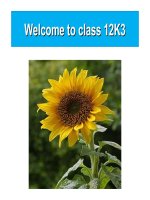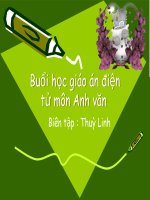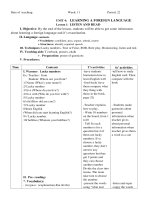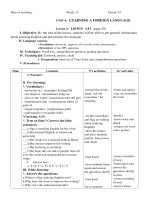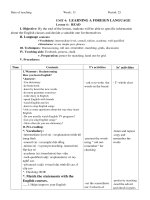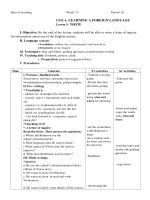unit 4 nc
Bạn đang xem bản rút gọn của tài liệu. Xem và tải ngay bản đầy đủ của tài liệu tại đây (77.31 KB, 14 trang )
<span class='text_page_counter'>(1)</span><div class='page_container' data-page=1>
Unit 4 :
<b>SPECIAL EDUCATION</b>
Lesson 1 : Reading
<b>Objective</b> : by the end of the lesson,students will be able to read & understand the text about
Helen Keller – a woman with strong dedication to helping the blind around the world.
<b>Teaching aids</b> : poster,picture
<b>Proceture</b> :
<b>T</b> <b>Teacher’s activities</b> <b>Students’ activities</b>
5’
10’
<b>I. Warm-up: Brainstorming</b>
- Asking ss to make a list of words that describe the
disabled people
- Gathering ideas from groups and leading in the lesson
disabled blind, can’t see, can’t
read or write, can’t walk
by themselves
deaf can’t hear
dumb can’t speak
mentally-retarded learn slowly, can’t
communicate
appropriately
<b>II. Pre-reading:</b>
1.Pre-teach Vocabulary:
-eliciting-modelling-checking meaning, pronounciation
<i><b>+ devoted oneself to something</b></i>
1. dedicated (a): tận tụy, tận tâm
2. painstakingly (adv): cần cù, cẩn thận
= carefully, industriously
3. consciousness (n)= awareness : nhận thức, ý thức
<i><b>+ a school in which students are prepared for entering</b></i>
<i><b>a college or uiversity.</b></i>
4. preparatory school (n): trường dự bị đại học
Checking Vocabulary: R . O . R
2.Set the scene
-Setting up the scene to introduce the reading by using
the pictures on page 42.
- Asking Ss to look at the pictures and answer the
- Listening & answering
- free answers:
-listening-answering-repeating
-copying down in notebook
- Possible answers:
+ 3 pictures
Week :<b>07</b>
Period:<b>25</b>
</div>
<span class='text_page_counter'>(2)</span><div class='page_container' data-page=2>
20’
questions.
<i><b>+ How many pictures are there? </b></i>
<i><b>+ What are the people in the pictures doing? </b></i>
<i><b>+ Where will these people study? </b></i>
<b>Part a:</b> <b>Schools for disabled children are called</b>
<b>special schools. Name some special schools you</b>
<b>know.</b>
- Sticking the poster on board
- Asking Ss to look at the poster on board
<b>Part b: These dots represent the alphabet of a</b>
<b>language for the blind. What is the name of the</b>
<b>language?</b>
<b>Part c: Quiz</b>
1. What do you call the people who cannot see?
2. What do you call the people who cannot hear?
3. What do you call the people who cannot speak?
<b>III. While-reading</b>
<b> </b>
:
- Asking Ss to open the textbook & read the text and
check prediction.
-Correcting & evaluating
- Sticking the poster on board
- Asking Ss to read the text again to put the following
events of Helen Keller’s life into chronological order
- Asking ss to work in individuals and groups
<b>Part a: Put the following events of Helen Keller’s</b>
<b>life into chronological order.</b>
She met Dr. Alexander Graham Bell.
She graduated from Radcliffe College.
She gave lectures and traveled to many countries.
She learned Braille.
She became blind and deaf.
She was born in 1880.
She met Anne Sullivan.
-Correcting & evaluating
- Asking Ss to read the text again to choose the correct
answer
- Asking ss to work in individuals and groups
<b>Part b: Which of the following ideas is not</b>
+ using their fingers to read and
their hands to express what they
mean
+ special schools
<b>Suggested answers</b>
Nguyen Dinh Chieu special
school for the blind / Xa Dan
special school for the Dumb and
Deaf / Binh Minh special
Primary school / Vo Thi Sau
special Primary school
- Looking at the poster &
listening to the instructions.
- Working in individuals
<b>Answer keys</b>:
Part b: Braille
Part c:
1. the blind
2. the deaf
3. the mute
- Opening the textbook
- Reading the text to check the
answers
- Looking at the poster
- Reading the text to put the
following events of Helen
Keller’s life into chronological
order
- Working in individuals
pairs
<b>Answers</b>:
1. She was born in 1880.
2. She became blind and deaf.
3. She met Dr. Alexander
Graham Bell.
4. She met Anne Sullivan.
5. She learned Braille.
</div>
<span class='text_page_counter'>(3)</span><div class='page_container' data-page=3>
10’
2’
<b>mentioned in the first and second paragraphs?</b>
A. At six, Helen Keller could not see, hear or speak.
B. Her parents took her to an expert to help her.
C. “Water” was the first word she learned.
D. She learned more than 600 words in six months.
-Correcting & evaluating
<b>IV. Post-reading: Discussion</b>
- Asking Ss to discuss “Helen Keller’s disabilities and
her efforts to overcome them”
Questions:
1. What was she like when she was born?
2. At what age did she become deaf and blind?
3. How did she learn words?
4. Which schools did she study?
5. What kind of teacher did she have?
<b>- Asking Ss to report the results of their discussion </b>
<b>to the class.</b>
<b>V. Homework: </b>
<b>- Asking Ss to learn the new words by heart</b>
7. She gave lectures and
traveled to many countries.
- Reading the text again to
choose the correct answer.
<b>Answers</b>: A
- Listening & discussing
- Working in individuals
groups
- free answers:
<b>- Reporting the results of their</b>
<b>discussion</b>
</div>
<span class='text_page_counter'>(4)</span><div class='page_container' data-page=4>
Unit 4 : SPECIAL EDUCATION
Lesson 2 : Reading
<b>Objective</b> : by the end of the lesson,students will be able to <b>read & understand the text about</b>
<b>Helen Keller – a woman with strong dedication to helping the blind around the world.</b>
<b>Teaching aids</b> : poster,picture
<b>Proceture</b> :
<b>T</b> <b>Teacher’s activities</b> <b>Students’ activities</b>
5’
10’
<b>I. Warm-up: Kim’s game</b>
blind mute deaf dedicated
tap out painstakingly consciousness
master manual preparatory
- Sticking the poster on board
- Asking ss to look at the poster and try to remember
the words
- Asking ss to rewrite them on board
- Correcting & evaluating
<b>II. Pre-reading:</b>
<b>1.Set the scene</b>
-Setting up the scene to introduce the reading by
making some questions.
- Asking Ss to answer the questions.
<i><b>+ What did you read the text about in the last period?</b></i>
<i><b>+ Why is she famous?</b></i>
<i><b>+ What is special about her?</b></i>
- Sticking the poster on board
- Asking Ss to look at the poster on board
-Giving instructions:
- Asking ss to work in individuals & groups
<b>True / False statement prediction</b>
1. Helen Keller became blind and deaf at the age of
seven.
2. Helen Keller graduated from Radcliffe College.
3. Dr. Alexander Graham Bell helped her understand
lessons and discussions in class.
4. She gave lectures and traveled to many countries.
- Listening & answering
- Working in groups
- Writing the words on board
Books-shut
- Listening & answering the
questions
- free answers:
- Looking at the poster &
listening to the instructions.
- Guessing and writing down
their predictions
- Working in individuals and in
groups
<b>Answers: </b>
1. F
2. T
3. F
4. T
Week :<b>07 </b>
Period: <b>26 </b>
</div>
<span class='text_page_counter'>(5)</span><div class='page_container' data-page=5>
20’
10’
2’
<b>III. While-reading:</b>
- Asking Ss to open the textbook & read the text and
check prediction.
-Correcting & evaluating
- Asking Ss to read the text again to answer the
questions.
<b>Part c: Answer the following questions:</b>
1. What happened to Helen at the age of six?
2. How old was she when she first met Anne Sullian?
3. What kind of language had Helen Keller learned
before Braille?
4. What does the phrase “cum laude” in the third
paragraph mean?
5. What was the role of Anne Sullivan during Helen’s
years at college?
- Correcting & evaluating
<b>IV. Post-reading</b>
<b>:</b><b> </b>
<b> Discussion</b>- Asking Ss to talk about “The significance of Helen
Keller’s success”
- Asking Ss to report the results of their discussion to
the class.
<b>V. Homework: </b>
- Asking Ss to do the exercises again
- Opening the textbook
- Reading the text to check the
answers
- Reading the text to answer
the questions in individuals
pairs
<b>Answers:</b>
1. She was blind and deaf.
2. She was 7 years old.
3. Helen Keller had learned sign
language before Braille.
4. It means “with honors”
5. She was a companion and
interpreter who helped Helen
understand lessons and
discussions in class.
- Listening & discussing these
questions in individuals
groups
<b>Free answers</b>:
+ She was determined to
succeed despite disability at
early age.
+ She finished high school and
college with honors.
+ She was a woman of golden
heart.
+ She helped other disabled
people by giving lectures and
raising charity fund.
- Reporting the results of their
discussion
</div>
<span class='text_page_counter'>(6)</span><div class='page_container' data-page=6>
Unit 4 : SPECIAL EDUCATION
Lesson 3 : Listening
<b>Objective</b> : by the end of the lesson,students will be able to be updated with background
information about institutions in the USA which specially used for and by the disabled and
improve listening skill by identifying key information for the answers
<b>Teaching aids</b> : poster,picture
<b>Proceture</b> :
<b>T</b> <b>Teacher’s activities</b> <b>Students’ activities</b>
6’
10’
18’
<b>I.Warm-up :</b>
-Asking Ss to locate the states of New York and
Alabama on the map in the book
-Asking Ss to work in groups
-Giving correct answers
<b>II.Pre-listening</b>
:<b>1.Set the scene</b> :
<i><b>+We have learned about the state of the USA. In </b></i>
<i><b>today’s listening, you will hear someone talking about </b></i>
<i><b>two schools for disabled children in the states of New </b></i>
<i><b>York and Alabama</b></i>
<b>2.Task C</b> : <b>True/False prediction</b>
- Sticking the poster on board
- Asking Ss to look at the poster on board
-Giving instructions:
<i><b>+How many sentences are there?</b></i>
<i><b>+Guess whether the statements are true (T) or false (F).</b></i>
<i><b>+Share your answers with friends in your groups </b></i>
1__The institute’s name is Alabama Institute for the
Deaf and Blind
2__It was founded in 1898
3__It does not have regional center
4__Disabled children and adults aged 3-21 can adjust
to a new way of life through special programs
particularly developed for them
<b>III.While-listening</b>
:<b>1.Checking True/False prediction</b>
-Asking Ss to listen to the second part of the recording
to check their guessing
-Working in groups
- Looking at the poster &
listening to the instructions.
- Guessing and writing down
their predictions
- Working in individuals and in
groups
<b>Answer keys</b>:
1. T
2. F (1858)
Week :<b>07</b>
Period:<b>27 </b>
</div>
<span class='text_page_counter'>(7)</span><div class='page_container' data-page=7>
10’
1’
-Calling on some Ss to explain their answer in front of
the class
-Giving correct answers
<b>2.Task B</b> : <b>Writing the words</b>
-Asking Ss to listen to the first part of the recording
independently and fill in the blanks
-Telling Ss to study the information required carefully
before listening
-Asking Ss to listen to the first part of the recording
1.Name of school __________
2.Students’disabilities _________
3.Year of foundation _________
4.Year the school name changed _________
-Having Ss compare their answers with a friend
-Calling on 2 Ss to write the answers on the board
-Asking for comments from other Ss
-Giving correct answers
<b>IV.Post-listening</b>
:-Asking Ss discuss and prepare an oral report of each
part in groups
-Giving suggested outline of the presentation :
1.Name of school
2.Year of foundation
3.School’s characteristics
4.Year the school name changed (part 1)
5.The relation between the Institute and the disabled in
Alabama (part2)
<b>V.Homework :</b>
-Asking Ss to summarizing the main points
3. F ( It has regional center
across the State of Alabama)
4.T
-Listening to do the exercise
-Writing the answers on board
<b>Keys :</b>
1.The New York Institution for
the blind
2.blindness or visual impairment
3.1831
4.early in the twentieth century
-Working in groups
-Presenting in front of the class
Week : <b>07</b>
Period: <b>28</b>
</div>
<span class='text_page_counter'>(8)</span><div class='page_container' data-page=8>
Unit 4 : SPECIAL EDUCATION
Lesson 4 : Speaking
<b>Objective</b> : by the end of the lesson,students will be able to express their opinions on the
problems of disabled children by using given prompts
<b>Teaching aids</b> : poster,picture
<b>Proceture</b> :
<b>T</b> <b>Teacher’s activities</b> <b>Students’ activities</b>
7’
13’
15’
<b>I.Warm-up : Brainstorming</b>
-Asking Ss to work in groups to make a list of the
problems that the disabled have to suffer
-Encourage Ss to contribute the ideas that they see
every day
-Gathering ideas from groups and make necessary
comments
<b>II.Pre-speaking</b>
:<b>1.Set the scene</b> :
<i><b>+A and B are talking about B’s friend, a visually </b></i>
<i><b>impaired girl. Now you work in pairs , read the </b></i>
<i><b>dialogue and fill in the blanks with necessary words/ </b></i>
<i><b>phrases from the table</b></i>
<b>2.Task A :</b>
-Asking Ss to read the dialogue carefully to have a
guess of the missing words before doing the task
-Calling on some pairs to act out the dialogue in front
of the class
-Feeding back and giving correct answers
<b>III.While-speaking :</b>
<b>Task B</b> :
-Asking Ss to work in pairs and make a similar
dialogue about the mute and deaf students by using the
prompts in the table
-Going around the class and provide help when
necessary
-Calling on several pairs to act out the conversation in
front of the class
-Making necessary corrections regarding Ss’
-Working in groups
<b>Suggested ideas</b> :
-can’t contact with others
-can’t see
-can’t hear
…………
-Working in pairs
-Presenting in front of the class
<b>Keys :</b>
1.difficulty seeing
2.walking stick
3.see
4.Braille,a pattern of raised dots
that are felt with fingers to help
the blind read
</div>
<span class='text_page_counter'>(9)</span><div class='page_container' data-page=9>
9’
1’
pronunciation and intonation
-Giving suggested answers
<b>IV.Post-speaking :</b>
<b>Task C : Discussion</b>
-Asking Ss work in groups and discuss the problems of
the deaf and mute in their daily life and what they can
do to help the disabled children
-Going around the class and providing help when
necessary.
-Gathering ideas from groups and having final thoughts
on the topic
<b>V.Homework</b>
:-Asking Ss to summarizing the main points
-Presenting the dialogue in front
of the class
<b>Suggested answers</b>
1.dificulty hearing and speaking
2.hearing aids
3.hear and speak
4.sign language and gestures are
used to communicate instead of
spoken language
-Working in groups
<b>Suggested ideas</b>
-teaching them to read and write
-playing game with them
-taking them to places of
interest
………
Week : <b>08</b>
Period: <b>29</b>
</div>
<span class='text_page_counter'>(10)</span><div class='page_container' data-page=10>
Unit 4 :
<b>SPECIAL EDUCATION</b>
Lesson 5 : Writing
<b>Objective</b> : by the end of the lesson,students will be able to fill in a registration form.
<b>Teaching aids</b> : poster,picture
<b>Proceture</b> :
<b>T</b> <b>Teacher’s activities</b> <b>Students’ activities</b>
8’
12’
<b>I. Warm-up: Matching</b>
- Sticking the poster on board
- Asking Ss to work in individuals and match the name
of some international tests in letters with their full
names
1. TOEFL a. International English
Language Testing System
2. IELTS b. Scholastic Assessment Test
3. TOEIC c. Test of English as a Foreign
Language
4. SAT d. Test of English for
International Communication
- Correcting & evaluating
<b>II. Pre-writing:</b>
<b>1.Set the scene</b>
- Asking Ss to answer the questions.
<i><b>+ On what occasions do you have to fill in a form? </b></i>
<i><b>+ What sort of information do you often have to provide</b></i>
<i><b>when you fill in a form? </b></i>
- Sticking the poster on board
- Asking ss to match a line in A with a question in B
- Asking ss to work in individuals in groups
<b>Match a line in A with a question in B:</b>
A B
1. First name a. What do you do?
2. Family name b. Where are you living at
the moment?
3. Date of birth c. What’s your passport
number?
4. Telephone d. What’s your first name?
5. Home address e. When were you born?
- Listening & answering
- Working in individuals and in
pairs
<b>Answers:</b>
1. c
2. a
3. d
4. b
- Listening & answering the
questions
- Looking at the poster
- Working in individuals and in
groups
<b>Answers:</b>
1. d
2. f
3. e
4. g
5. b
</div>
<span class='text_page_counter'>(11)</span><div class='page_container' data-page=11>
13’
13’
6. Passport
number
f. What’s your family
name?
7. Occupation g. What’s your telephone
number?
- Correcting & evaluating
<b>III. While-writing: </b>
- Asking ss to read the dialogue and fill in the form on
page 48
- Asking Ss to work in individuals and in groups .
- Moving around to control and giving help with
vocabulary.
INTERNATIONAL SCHOOL OF ENGLISH
REGISTRATION FORM
Personal Details
+ Family name:
+ First name:
+ Date of birth:
+ Home address:
+ Home country:
+ Telephone:
+ Fax:
+ E-mail:
+ Sex: M F
+ Occupation:
+ Passport number:
Course Details
+ Check () the course you are interested in.
GENERAL ENGLISH
INTENSIVE ENGLISH
INTERNATIONAL BUSINESS ENGLISH
ACADEMIC ENGLISH COURSE
(SCHOOL)
TOEFL
IELTS
TOEIC
. . .
Signature
<b>IV. Post-writing:</b>
<b>Correcting</b>- Choosing the best piece of writing & the worst piece
of writing to correct.
- Asking Ss to exchange their writing with another
7. a
- Looking at the handouts &
listening
- Working in individuals
groups
- Writing on poster and sticking
on board
</div>
<span class='text_page_counter'>(12)</span><div class='page_container' data-page=12>
2’
student for peer correction.
- Giving general comments.
<b>V. Homework</b>
:
- Asking Ss to rewrite a registration form
<b>Answers:</b>
+ Family name: Tran
+ First name: Linh
+ Home address: 555, Nguyen
Chi Thanh, Da Nang
+ Home country: Vietnam
+ Telephone:05-8356111
+ Sex: M
TOEFL
- Listening & taking notes in
notebooks
<sub>Week :</sub><b><sub>08</sub></b>
Period: <b>30</b>
</div>
<span class='text_page_counter'>(13)</span><div class='page_container' data-page=13>
Unit 4 :
<b>SPECIAL EDUCATION</b>
Lesson 6 : Writing
<b>Objective</b> : by the end of the lesson,students will be able to fill in a registration form.
<b>Teaching aids</b> : poster,picture
<b>Proceture</b> :
<b>T</b> <b>Teacher’s activities</b> <b>Students’ activities</b>
8’
12’
<b>I. Warm-up: Jumbled words</b>
1. guagelang
2. tercen
3. rsecou
4. arnle
5. akspe
- Sticking the poster on board
- Asking Ss to work in groups
- Asking ss to write the correct words on board
- Correcting and evaluating
<b>II. Pre-writing:</b>
<b>1.Set the scene</b>
<i><b>+Who is this?</b></i>
<i><b>+What does she want to do?</b></i>
<b>Part b: Read the text and complete the</b>
<b>questionnaire with information about Nguyen Thi</b>
PHU DONG LANGUAGE CENTER
Name:
Date of birth:
Why do you take this course?
How long have you learned English?
Which language(s) do you speak?
- Asking ss to work in individuals and in pairs
- Asking ss to complete the questionnaire with
information about Nguyen Thi
- Asking Ss to write the answers on board.
- Correcting and evaluating
- Sticking the poster on board
- Listening & answering
- Working in groups
<b>Answers:</b>
1. language
2. center
3. course
4. learn
5. speak
- Listening & answering
- Working in individuals and in
pairs
- Completing the questionnaire
with information about Nguyen
Thi
<b>Answers:</b>
PHU DONG LANGUAGE
CENTER
Name: Nguyen Thi
Date of birth: October 21st<sub>, 1990</sub>
Why do you take this course? I
want to improve my English
because I want to study in an
English-speaking country.
How long have you learned
English? 5 years
</div>
<span class='text_page_counter'>(14)</span><div class='page_container' data-page=14>
13’
13’
2’
<b>III. While-writing: </b>
- Asking ss to complete the questionnaire with their
own information
- Asking Ss to work in individuals and in groups .
- Moving around to control and giving help with
vocabulary.
<b>Complete the questionnaire with your own</b>
<b>information</b>
VINH LONG LANGUAGE CENTER
Name:
Date of birth:
Why do you take this course?
How long have you learned English?
Which language(s) do you speak?
<b>IV. Post-writing</b>
<b>:</b><b> </b>
<b>Correcting</b>- Choosing the best piece of writing & the worst piece
of writing to correct.
- Asking Ss to exchange their writing with another
student for peer correction.
- Giving general comments.
<b>V. Homework</b>
:- Asking Ss to rewrite the exercises in notebooks
- Writing on poster and sticking
on board
- Looking at the board
- Correcting
<b>Free answers:</b>
</div>
<!--links-->


